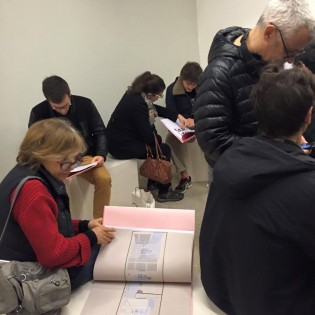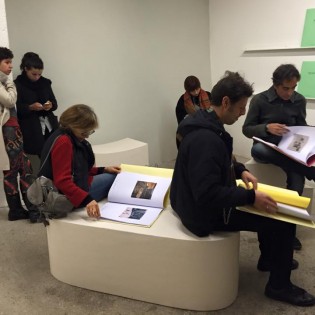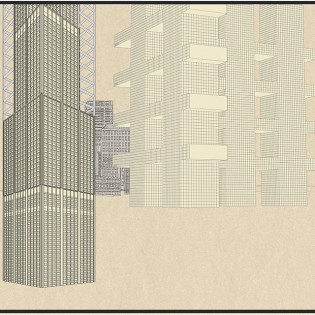The exhibition “Misunderstandings”, held jointly by Campo gallery (Rome) and Le FRAC Center (Orleans, France), was intended as an experiment on what should be a historical collection and how contemporary architectural practice can approach it.
To do so, twelve architects and artists were invited by curators Gianfranco Bombaci, Matteo Costanzo, Luca Galofaro and Davide Sacconi to make a project from a drawing chosen from the Le FRAC collection. Guided only by the conceptual and plastic power of the drawings, the interpretation was open to all “misunderstandings”, such as scientific errors and historical inadequacies, to embody creative and fertile narratives.
One of the twelve works that make up the show is our “The Grid”. We publish here parts of this four-meter long drawing. The sequence was made from a diptych provided by the curators (by architect David Georges Emmerich, 1925-1996) on which we made interventions to create a “stilted” landscape that corrupts the original design and celebrates incompleteness.
An excerpt form the project description:
“(…) Now, could these palafittes be regarded as an unusual phenomenon of international scope? As a caricature of themselves used in an infiltrating system that eventually becomes universal? Can this space taken as residual and malefic be exported to other finished architectures and invade stable buildings? The effect of this operation can be surprisingly positive as a mathematical operation: minus x minus = plus (as well as it risks operating only as a nostalgic revival of some notorious critiques of modernism).
“There is an expectant energy found only in incompleteness, in emptiness and in the ordinary that lies just around us. Assuming the ambitions of a universal multiplication, in this new scale the palafittes grid is applied to several buildings and has nothing to do with their original urban contexts. It not only complements, but also enhances found architectures we take as starting point for an addition: the whole architecture of the city is now imaginary expectancies to be extended, thus fulfilling an unconscious intention of a return to a primitive state, under construction, in a state of becoming. The grid is inserted without any distinction: either in prosaic, emblematic, symbolic, ordinary buildings; on the periphery, in the center; here, there. It spreads itself randomly, leading freedom of uses to tight buildings, encouraging new activities in public spaces, extending its absolute beauty like a tumor capable of reinvigorating moribund architectures. It has something that denotes buildings in process, which transforms finished architectures into unfinished architectures and gives to completed buildings the possibility of transformation. (That is why every building is beautiful when it is under construction: at this stage there is still hope that some architecture will appear, or perhaps that the result of that construction is not going to be as predictable or mediocre as its finished neighbors). A city infected by this system is a city forever under construction, forever incomplete, forever a “process” and never a “product”. A city of spontaneous metabolist, non-designed structures.
“For each building, two architectures: one is prescribed, the other is open. As in a symbiotic relationship, this additional architecture fits like a glove in the original buildings to a point that is difficult to look back at them without the feeling that something is lacking. The city produced by this operation is compact and thin, finished and unfinished, generic and unique. Pervading buildings in different positions (atop, beneath, between), what we see is an arrhythmic sequence of indeterminate space reservoirs. Moreover, this corruption of the existent is full of change, freedom, mutability, opening unprecedented opportunities for a new public domain beyond the public-private polarization.”
More on the drawings in our website blog, “The Grid: a landscape of colonizing voids“.













